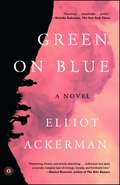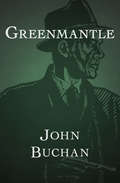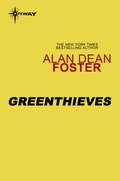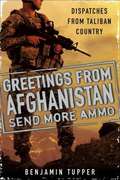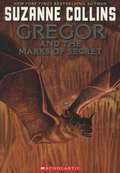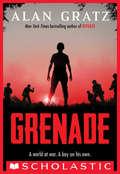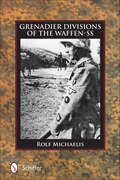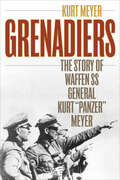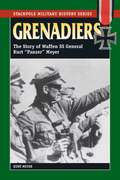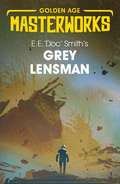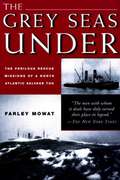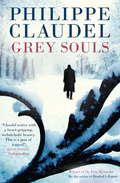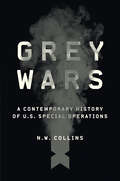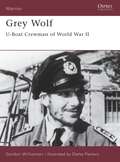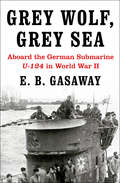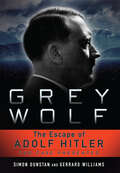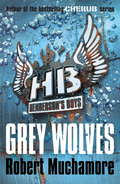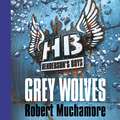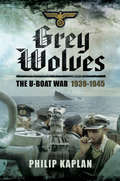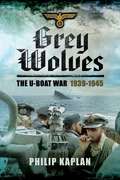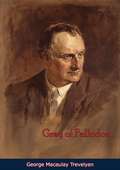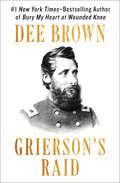- Table View
- List View
Green and Pleasant Land (The Rachel Patten Dramas)
by Teresa CraneThe Great War is over, the Roaring Twenties dawn. Three women’s lives are about to change forever... Rachel Patten is an undoubted beauty, yet the only man she wants is the one who rejects her. But then rebellion takes her across strict class boundaries into the arms of her gamekeeper, Gideon Best…Daphne Underscar - plain, gauche, but far from stupid - knows full well that the ambitious Toby Smith married her for money. With love, and with courage, she is prepared to gamble her own happiness on the hope of a more fulfilling relationship. Meanwhile Philippa Van Damme has led a sheltered life, her childhood severed abruptly by a wrenching bereavement. Thrust headlong into an unstable post-war world, her hopes of a future with Hugo Fellafield are dashed by familial discord, and the threat of political scandal. From industrial London to the tropical landscape of Madeira, Green and Pleasant Land follows the three women in a triumphant sequel to Tomorrow, Jerusalem. Perfect for fans of Julia Quinn and Victoria Hislop.
Green on Blue: A Novel
by Elliot AckermanFrom a decorated veteran of the Iraq and Afghan Wars, and White House Fellow, a stirring debut novel about a young Afghan orphan and the harrowing, intractable nature of war.Aziz and his older brother Ali are coming of age in a village amid the pine forests and endless mountains of eastern Afghanistan. There is no school, but their mother teaches them to read and write, and once a month sends the boys on a two-day journey to the bazaar. They are poor, but inside their mud-walled home, the family has stability, love, and routine. When a convoy of armed men arrives in their village one day, their world crumbles. The boys survive and make their way to a small city, where they sleep among other orphans. They learn to beg, and, eventually, they earn work and trust from the local shopkeepers. Ali saves their money and sends Aziz to school at the madrassa, but when US forces invade the country, militants strike back. A bomb explodes in the market, and Ali is brutally injured. In the hospital, Aziz meets an Afghan wearing an American uniform. To save his brother, Aziz must join the Special Lashkar, a US-funded militia. No longer a boy, but not yet a man, he departs for the untamed border. Trapped in a conflict both savage and entirely contrived, Aziz struggles to understand his place. Will he embrace the brutality of war or leave it behind, and risk placing his brother--and a young woman he comes to love--in jeopardy? Having served five tours of duty in Afghanistan and Iraq, Elliot Ackerman has written a gripping, morally complex debut novel, an astonishing feat of empathy and imagination about boys caught in a deadly conflict.
Greenmantle
by John BuchanThe second installment in the electrifying adventures of Richard Hannay, Britain’s greatest secret agentMajor Richard Hannay, hero of The Thirty-Nine Steps, is recovering from wounds sustained in the bloody Battle of Loos when his old friend Sir Walter Bullivant summons him to the Foreign Office. Hoping for a promotion, Hannay is asked instead to investigate rumors that a “star rising in the West” is about to bring the entirety of the Muslim world under the Kaiser’s control. Hannay enlists the help of a polyglot British soldier and a dyspeptic American spy to go undercover first in Germany and then in Constantinople, where the glamorous and enigmatic Hilda von Einem is behind the conspiracy. In a stunning climax set during the pivotal clash between Russian and Ottoman forces over the Turkish city of Erzerum, Hannay and his cohorts risk everything to ensure that England and her allies will live to fight another day.With its skillful blend of political insight and heart-stopping action, Greenmantle was a huge step forward in the development of the modern espionage novel. It was also, and still very much is, an irresistible thrill ride from first page to last.This ebook has been professionally proofread to ensure accuracy and readability on all devices.
Greenthieves
by Alan Dean FosterNobody could get in. Nobody could get out. But somebody did. The theft of three shipments of priceless pharmaceuticals from the Braun-Ives corporation has left the local police dumbfounded. Enter Broderick Manz, the highly paid and highly resourceful Adjuster from the Insurance Division. With the help of the irresistible Vyra, whose charms are truly out of this world, the irrepressible humaniform Moses, and the irreverent Minder, an artificial intelligence, Manz soon finds himself in the heart of the criminal underworld. And it really is a jungle out there.
Greetings From Afghanistan, Send More Ammo
by Benjamin Tupper"Raw, direct, and powerful. . . This work is vitally important. " -Ken Stern, former CEO of National Public Radio Captain Benjamin Tupper spent a year in Afghanistan in an Embedded Training Team, tasked with training, leading in combat, and mentoring the Afghan Army to victory against the brutal Taliban. Writing and recording from a remote outpost, Tupper's dispatches were posted on the blog The Sandbox and broadcast on NPR, bringing vivid snapshots of America's longest ongoing war to a wide audience back home. Here, he takes us inside the intricacies of the war, opening up a unique and multifaceted view of both Afghan culture and the daily life of an American soldier. From the rush of gunfire to surreal, euphoric moments of cross-cultural understanding, this emotional and thought- provoking narrative is rich with humor, eloquence and contradiction. Deeply personal and darkly funny, Tupper illuminates the challenges of the war, vividly bringing to life both the mundane and the extraordinary and seeking a way forward.
Gregor and the Marks of Secret (Underland Chronicles Book #4)
by Suzanne CollinsGregor is drawn even deeper into a brewing crisis. For generations rats have run the mice out of whatever lands they've claimed, but now the mice are disappearing and Gregor must find out why.
Grenada 1983
by Paul Hannon Lee RussellOn 21 October 1983, following the death of Prime Minister Maurice Bishop, the leaders of the six small nations forming the Organization of Eastern Caribbean States voted to intervene militarily to restore order in Grenada. As none possessed the forces necessary to carry out a successful operation, the United States, fearing for its citizens on the island, and wanting to curb Cuba's growing influence, decided to get involved. This book provides a day-by-day account of the US invasion of Grenada, focusing on the units and forces deployed. Numerous contemporary photographs and colour plates detail the uniforms and equipment of the US, Cuban and Caribbean forces.
Grenade
by Alan GratzIt's 1945, and the world is in the grip of war. <P><P>Hideki lives with his family on the island of Okinawa, near Japan. When WWII crashes onto his shores, Hideki is drafted into the Blood and Iron Student Corps to fight for the Japanese army. He is handed a grenade and a set of instructions: Don't come back until you've killed an American soldier. <P><P>Ray, a young American Marine, has just landed on Okinawa. This is Ray's first-ever battle, and he doesn't know what to expect -- or if he'll make it out alive. He just knows that the enemy is everywhere. <P><P>Hideki and Ray each fight their way across the island, surviving heart-pounding ambushes and dangerous traps. But then the two of them collide in the middle of the battle...And choices they make in that single instant will change everything. <P><P>Alan Gratz, New York Times bestselling author of Refugee, returns with this high-octane story of how fear and war tear us apart, but how hope and redemption tie us together. <P><b>A New York Times Bestseller</b>
Grenadier Divisions of the Waffen-SS
by Rolf MichaelisConcise history of all 18 Waffen-SS grenadier divisions in WWII
Grenadiers: The Story of Waffen SS General Kurt "Panzer" Meyer
by Kurt MeyerReprint of the classic World War II memoir German General Kurt "Panzer" Meyer's autobiography is a fascinating insight into the mind of one of Germany's most highly decorated and successful soldiers of World War II. If you love small-unit actions, this is the book for you. Follow Meyer with the 1st SS-Panzer Division "Leibstandarte" and the 12th SS-Panzer Division "Hitlerjugend," from the first day of the war in Poland, through service in France, Russia, and Greece, up until his capture in Normandy in 1944 and his postwar trials and tribulations.
Grenadiers: The Story of Waffen SS General Kurt "Panzer" Meyer (Stackpole Military History Series)
by Kurt Meyer• Reprint of the classic World War II memoirGerman General Kurt "Panzer" Meyer's autobiography is a fascinating insight into the mind of one of Germany's most highly decorated and successful soldiers of World War II. If you love small-unit actions, this is the book for you. Follow Meyer with the 1st SS-Panzer Division "Leibstandarte" and the 12th SS-Panzer Division "Hitlerjugend," from the first day of the war in Poland, through service in France, Russia, and Greece, up until his capture in Normandy in 1944 and his postwar trials and tribulations.
Grey Lensman (Golden Age Masterworks)
by E.E. 'Doc' SmithSomewhere among the galaxies is the stronghold of Boskone - a network of brilliant space-criminals whose hunger for conquest threatens the continued existence of all known civilisation.But where is this stronghold? Boskonian bases are scattered across the universe - hidden by gigantic thought-screens that defy penetration. The best minds in the Galactic Patrol have tried. And failed. Now it is up to Lensman Kim Kinnison, using his fantastic powers, to infiltrate the Boskonian strongholds, find the location of the enemy's Grand Base - and smash it forever.But Kinnison doesn't know that the power of Boskone reaches further than anyone dreamed - into the Galactic Patrol itself . . .Grey Lensman is the fourth self-contained novel in E. E. 'Doc' Smith's Lensman series, one of the all-time classics of adventurous, galaxy-spanning science fiction.
Grey Seas Under: The Perilous Rescue Mission Of A N.A. Salvage Tug
by Farley MowatThe hair-raising rescue missions of a deep-sea salvage tug that saved hundreds of lives during two decades of service in the North Atlantic.
Grey Souls
by Philippe ClaudelA bestseller in France and winner of the Prix Renaudot, Grey Souls is a mesmerising and atmospheric tale of three mysterious deaths in an oddly isolated French village during World War I. The placid daily life of a small town near the front seems impervious to the nearby pounding of artillery fire and the parade of wounded strangers passing through its streets. But the illusion of calm is soon shattered by the deaths of three innocents - the charming new schoolmistress who captures every male heart only to kill herself; an angelic ten-year-old girl who is found strangled; and a local policeman's cherished wife, who dies alone in labour while her husband is hunting the murderer. Twenty years later, the policeman still struggles to make sense of these tragedies, a struggle that both torments and sustains him. But excavating the town's secret history will bring neither peace to him nor justice to the wicked.
Grey Wars: A Contemporary History of U.S. Special Operations
by N. W. CollinsAn analysis of U.S. Special Operations, at the center of America’s twenty-first-century wars “Grey Wars is for anyone who wants to understand today’s fights. Collins has done a great service by providing a well-sourced, clear, and insightful look into the missions and activities of U.S. special operators. Highly recommend.”—Mike Thornton, USN Seal (ret.), Congressional Medal of Honor recipient, and coauthor, By Honor Bound “Fascinating and deeply researched, covering the defining moments in modern special operations; Grey Wars is a must-read for anyone interested in the post 9/11 world.”—Admiral William H. McRaven, USN (ret.), Ninth Commander of the U.S. Special Operations Command This original and accessible book is a comprehensive, authoritative analysis of U.S. Special Operations. U.S. Special Operations Command trains and equips units to undertake select military activities, frequently high-risk missions, often for the purposes of counterterrorism and counterinsurgency. Since 9/11, impelled by an attack on U.S. soil, these forces have been a central instrument of America’s military campaign—operating in about one hundred countries on any given day. This fight—neither hot war nor cold peace—was launched and executed as a new type of global war in 2001 and has since splintered into a spectrum of regional conflicts. The result is our nation’s grey wars: hazy and lethal. This contemporary history, incorporating extensive interviews and archival research by security studies expert N. W. Collins, delves deeply into the transformation of these forces since 9/11.
Grey Wolf
by Darko Pavlovic Gordon WilliamsonThe scourge of Allied shipping during World War II, the U-Boot Waffe was one of the most feared components of Hitler's war machine, yet the Kriegsmarine was the least political branch of the Third Reich. The sailors of the U-boat arm were courageous, highly skilled seamen, who fought a war in the toughest conditions: subject to immense tension, and forced to cope with the challenges of the Atlantic, life for a U-boat recruit was far from easy. This title explores the life of a typical U-boat crewman, from recruitment, through training and service conditions, to combat experience throughout the war. Illustrated with many previously unpublished images, this book offers a fresh insight into the experiences of the men in Dönitz's legendary 'wolf packs'.
Grey Wolf, Grey Sea: Aboard the German Submarine U-124 in World War II
by E. B. GasawayThe inside story of life aboard the deadly Nazi U-Boat that sank forty-nine ships. The history of one of World War II&’s most successful submarines, U-124, is chronicled in Grey Wolf, Grey Sea, from its few defeats to a legion of victories. Kapitanleutnant Jochen Mohr commanded his German submarine and navigated it through the treacherous waters of one of the most destructive, savage wars the world has known.
Grey Wolf: The Escape of Adolf Hitler
by Simon Dunstan Gerrard WilliamsDID HITLER--CODE NAME “GREY WOLF”--REALLY DIE IN 1945?GRIPPING NEW EVIDENCE SHOWS WHAT COULD HAVE HAPPENED… When Truman asked Stalin in 1945 whether Hitler was dead, Stalin replied bluntly, “No.” As late as 1952, Eisenhower declared: “We have been unable to unearth one bit of tangible evidence of Hitlers death.” What really happened?Simon Dunstan and Gerrard Williams have compiled extensive evidence--some recently declassified--that Hitler actually fled Berlin and took refuge in a remote Nazi enclave in Argentina. The recent discovery that the famous “Hitlers skull” in Moscow is female, as well as newly uncovered documents, provide powerful proof for their case. Dunstan and Williams cite people, places, and dates in over 500 detailed notes that identify the plans escape route, vehicles, aircraft, U-boats, and hideouts. Among the details: the CIAs possible involvement and Hitlers life in Patagonia--including his two daughters.
Grey Wolves: Book 4 (Henderson's Boys #4)
by Robert MuchamoreSpring, 1941.German submarines are prowling the North Atlantic, sinking ships filled with the food, fuel and weapons that Britain needs to survive. With the Royal Navy losing the war at sea, six young agents must sneak into Nazi-occupied Europe and sabotage a submarine base on France's western coast. If the submarines aren't stopped, the British people will starve.
Grey Wolves: Book 4 (Henderson's Boys #4)
by Robert MuchamoreSpring, 1941.German submarines are prowling the North Atlantic, sinking ships filled with the food, fuel and weapons that Britain needs to survive. With the Royal Navy losing the war at sea, six young agents must sneak into Nazi-occupied Europe and sabotage a submarine base on France's western coast. If the submarines aren't stopped, the British people will starve.(P) Hodder Children's Books 2015
Grey Wolves: The U-Boat War, 1939–1945
by Philip KaplanIn the early years of the Second World War, the elite force of German submariners known as the Ubootwaffe came perilously close to perfecting the underwater tactics of the First World War and successfully cutting Britain's transatlantic lifeline. To the Allies, these enemy sailors were embarking on a mission that was unequivocally evil.It was popularly believed that the U-boat men were all volunteers; this was not the case. However, once committed to the Ubootwaffe, each man soon understood that he must take pride in being part of a unique brotherhood. He had to do so because he was setting out, in claustrophobic, unsanitary, stench-filled and ultimately hellish conditions, on a journey that would test his mental and physical endurance to the very limits, and one that he had little chance of surviving. Those that did return soon ceased to take comfort in friends or family, dwelling only on the knowledge that another patrol awaited them. The men of the Ubootwaffe were bound together by an intense camaraderie forged in an environment of ever-present danger, and a unity of purpose more powerful than any known to other sailors.As the U-boat memorial near Kiel records, by the end of the war, of the 39,000 men who went to sea in the U-boats, 27,491 died in action and a further 5,000 were made prisoners of war. Of the 863 U-boats that sailed on operational patrols, 754 were lost.Grey Wolves captures life on board a U-boat, in text, letters, diaries, journals, memoirs, prose and poetry, relaying tales of the mundane and the routine, dramatic and heroic; the fear and resilience of every crew member, from Kapitainleutnant to Mechaniker. It is a vivid, brutally realistic portrait of the men who fought and died beneath the surface of the Atlantic in what was, perhaps, the most critical battle of the war.
Grey Wolves: The U-Boat War, 1939–1945
by Philip KaplanIn the early years of the Second World War, the elite force of German submariners known as the Ubootwaffe came perilously close to perfecting the underwater battle tactics and successfully cutting Britain's transatlantic lifeline. To the Allies, these enemy sailors were embarking on a mission of unequivocal evil.Each member of the Ubootwaffe understood that he must take pride in being part of a unique brotherhood. He had to do so because he was setting out-in claustrophobic, unsanitary, stench-filled, and ultimately hellish conditions-on a journey that would test his mental and physical endurance to the very limits, and which he had little chance of surviving. Those that did return soon ceased to take comfort in friends or family, dwelling only on the knowledge that another patrol awaited them. By the end of the war, of the 39,000 men who went to sea in the U-boats, 27,491 died in action and a further 5,000 were made prisoners of war. Of the 863 U-boats that sailed on operational patrols, 754 were lost.Grey Wolves captures life on board a U-boat, in text, letters, diaries, journals, memoirs, prose, and poetry, relaying tales of the mundane and the routine, dramatic and heroic; the fear and resilience of every crew member, from Kapitainleutnant to Mechaniker. It is a vivid, brutally realistic portrait of the men who fought and died beneath the surface of the Atlantic in what was, perhaps, the most critical battle of the war.
Grey of Fallodon: The Life And Letters Of Edward Grey
by George Macaulay TrevelyanEdward Grey, 1st Viscount Grey of Fallodon, KG, PC, DL, FZS (1862-1933), better known as Sir Edward Grey prior to his elevation to the peerage he was the 3rd Baronet Grey of Fallodon, was a British Liberal statesman and the main force behind British foreign policy in the era of the First World War. An adherent of the “New Liberalism”, he served as foreign secretary from 1905-1916, the longest continuous tenure of any person in that office. He is probably best remembered for his “the lamps are going out” remark on 3 August 1914 on the outbreak of the First World War. He signed the Sykes-Picot Agreement on 16 May 1916 and ennobled that same year, he was Ambassador to the United States between 1919-1920 and Leader of the Liberal Party in the House of Lords between 1923-1924.In his own words, renowned British historian George Macaulay Trevelyan’s object of this volume was “to present the man, his character as moulded by circumstance, and his life private and public.” Sir Edward Grey had particularly expressed the desire that his private life, including the twenty years of his first marriage, ought to be an integral part of any biography of him that was written with the help of his family and trust friends, and Trevelyan has successfully achieved this with this biography.An unmissable addition to any World War I library.
Grierson's Raid: A Cavalry Adventure Of The Civil War
by Dee BrownThe improbable Civil War raid that led to the Siege of Vicksburg, recounted by the #1 New York Times–bestselling author of Bury My Heart at Wounded Knee. For two weeks in the spring of 1862, Colonel Benjamin Grierson and 1,700 Union cavalry troopers conducted a raid from Tennessee to Louisiana. It was intended to divert Confederate attention from Ulysses S. Grant&’s army crossing the Mississippi River, a maneuver that would set the stage for the Siege of Vicksburg. Led by a former music teacher whose role in the Union cavalry was belied by his hatred of horses, Grierson&’s Raid was not only brilliant, but improbably successful. The cavalrymen ripped up railway track, destroyed storehouses, took prisoners, and freed slaves. Colonel Grierson lost only three men through the whole expedition. Rich and detailed, Grierson&’s Raid is the definitive work on one of the most astonishing missions of the Civil War&’s early days. This ebook features an illustrated biography of Dee Brown including rare photos from the author&’s personal collection.

